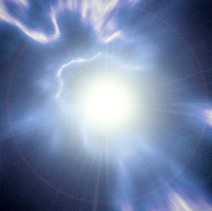Gamma-ray bursts are flashes of gamma rays, associated with the most energetic explosions in the universe. Could some of them be white holes? This is the new proposal of Alon Retter and Shlomo Heller, describing white holes as “small bangs”.
Gamma-ray bursts are classified in two categories: long gamma-ray bursts, and short gamma-ray bursts, according to their duration. Long bursts last more than two seconds; they usually occur in star-forming galaxies and they are in many cases related to supernovae explosions. Short bursts occur in regions of low star-formation, which rules out an association with massive stars. They probably originate from the mergers of binary neutron stars, but their true nature is still unknown.
Some gamma-ray bursts do not belong to any of these categories, as they show features of both groups. GRB 060614 is one of them: it lasted about 102 seconds, with no supernova emission. Retter and Heller now suggest that such bursts might actually be white holes.

White holes are, basically, the reverse of black holes. They cannot be entered from the outside, but matter and light can escape from them. Although white holes appear in the solutions of Einstein’s field equations, they remain hypothetical as none have been observed so far. Their origin comes from the idea that spacetime should not have any “edges”. Then, how to avoid the problem raised by the gravitational singularity at the center of a black hole? A possible solution comes from the hypothetical connection of a black hole and a white hole, known as a wormhole.
As they can be understood as the time reversal of black holes, white holes would constantly eject matter. Because of their gravitational pull, white holes would accrete matter around their event horizon, until eventually everything collapses… into a black hole. Retter and Heller have a different view: they suggest that white holes would actually eject all matter at once in a single instance.
It was proposed that the Universe itself originated from a white hole: a weaker white hole would then be a “Small Bang”. When a large amount of mass is ejected, the white hole would eventually collapse into a black hole. As these white holes are not connected to any supernova event and can theoretically appear anywhere, the authors suggest they might be the origin of peculiar gamma-ray bursts such as GRB 060614. They also believe that such white holes could explain the formation of asymmetric structures in the early universe, leading to the formation of galaxies and galaxy clusters we observe today.
Of course, all this is just an idea, and it is impossible to tell whether some gamma-ray bursts are white holes. Maybe GRB 060614 was a white hole. The only way to know is to wait for future similar events, and carry on observations. Maybe then something in the data will back this new proposal, or rule it out completely.
